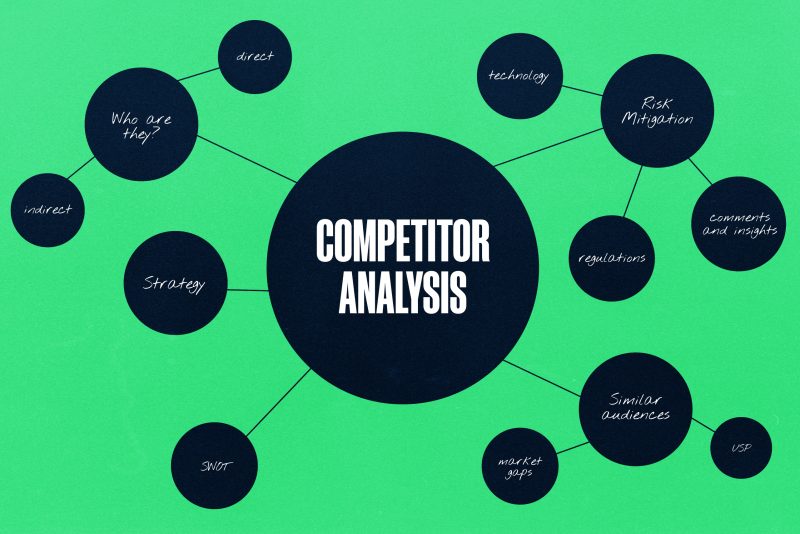
01/24 | Impact
Competitor analysis – why it’s essential and why you should do more
The current marketing landscape is undeniably formidable.
With new promotional and communication channels emerging at an alarming rate, navigating this landscape presents unique challenges to even the most marketing-savvy businesses.
It’s getting more important than ever for businesses to not only sustain their success but also outpace their competitors.
One aspect of marketing strategy that often gets overlooked is competitor analysis.
Are you doing enough?
Do you need to be doing more?
What is competitor analysis?
Competitor analysis involves researching and dissecting your competitor’s marketing strategy, providing a benchmark for your own and a baseline in which to analyse comparisons. This allows you to understand your shared audiences better, identify opportunities and stay on top of industry trends.
It’s essential to ensure you are not just keeping pace with the market but leading the way. It’s a comprehensive analysis of your competitor’s strategies, strengths, weaknesses, and market positioning. This analytical approach is not just about keeping tabs on your rivals but ensuring a strategic approach that can mean huge success for your business.
Competitor analysis could be the secret weapon in your arsenal that keeps you ahead of the curve, and privy to any mistakes or mishaps that have previously tripped up your competitors.
Think of competitor analysis as the backstage pass to your competitors’ show. By dissecting their strategies, strengths and weaknesses, you can better understand their moves and victories, and realign your strategy accordingly.

Similar audiences
Your competitors are naturally marketing to the same audiences as you. But it’s not just about the obvious targets. Direct competitors are the ones offering similar products or services, while indirect competitors might be lurking in the shadows, catering to a slightly different market but still vying for your customers’ attention.
By understanding where your competitors stand, you can find your place in the market, identify gaps, and offer something unique. Or even identify audiences you didn’t know were there before!
Risk mitigation
Keeping a close eye on your competitors means you can mitigate risks and learn from their mistakes and mishaps.
Diligently monitoring your competitors’ strategic moves allows you to pinpoint emerging risks, sometimes before they even occur.
Whether it’s shifts in consumer preferences, technological disruptions, or regulatory changes, competitor analysis will give you that foresight, and offer glimpses into possible uncertainties.
Social listening is another great tool for risk mitigation in competitor analysis. If a new campaign from a competitor has attracted some contentious comments or negative reactions from audiences, you can delve into those insights and work out what is going wrong – and avoid it in the future!
This puts you in a very powerful position.

Empowered decision-making
Competitor analysis can also serve as the foundation for more strategic decision-making. Whether that’s shaping marketing campaigns, competitive pricing, or developing new products, understanding your competitor’s strategy will provide the context you need to make decisions aligned with broader market dynamics.
Competitor analysis equips your business with the knowledge to adapt and evolve. By staying on top of market dynamics and competitor’s moves, you can quickly adjust strategies, and ensure your business doesn’t just react to change but acts strategically.
With tangible insights into what’s working and what’s not for your competitors, you have something solid to base your decisions on, and may even get more buy-in from those in leadership positions, meaning more budget and potential for your own campaigns!
Conducting a competitor analysis
Here are some facets of competitor analysis to consider before diving in:
- Identify who your competitors are. Remember to include direct and indirect competitors.
- What products or services do they offer? Which are similar to yours?
- Identify gaps in their offering. What could they offer that they currently don’t?
- What are their marketing tactics and results? For example, which keywords are they ranking for, or how many impressions and engagements are they getting on social media?
- Where are they hanging out? Where do your audiences contact them and how do they respond?
- What pricing strategy and tactics are they using? What seems to be working and what doesn’t?
- A SWOT to analyse their strengths weaknesses, opportunities and threats – this helps you explore every angle of their performance
- Take note of their content marketing strategy – where are they paying the most attention?
Without a solid competitor analysis strategy, you’ll have no idea what you’re up against.
Vying for attention online is becoming harder and harder. Every marketer and business owner should constantly be looking for ways to gain an edge over their competitors – where they’re empowered to make strategic decisions that will break through all of the noise and attract the right audiences.
Want to explore your strategic marketing strategy with Stratos by your side? Drop us a line whenever you’re ready.
